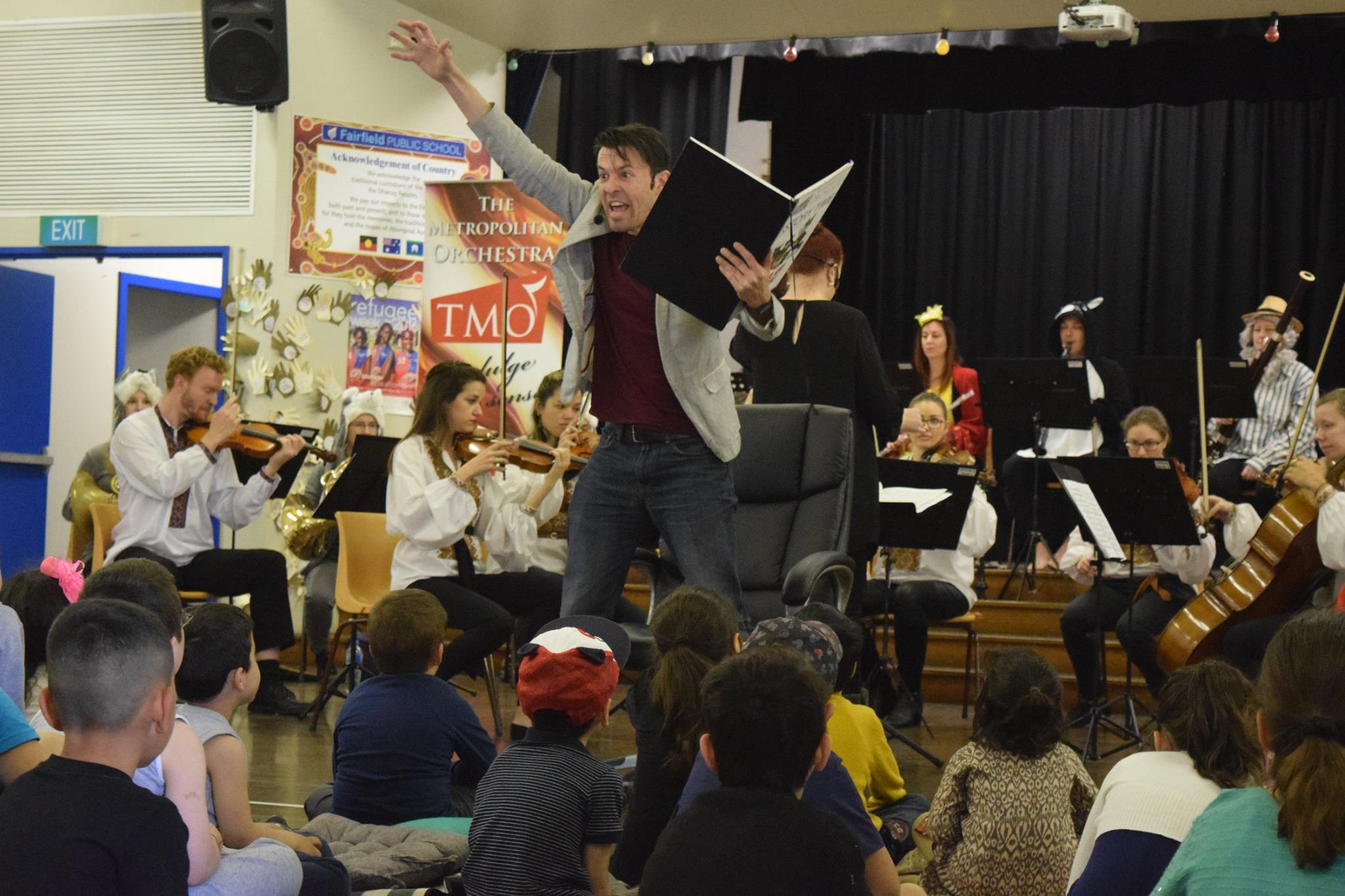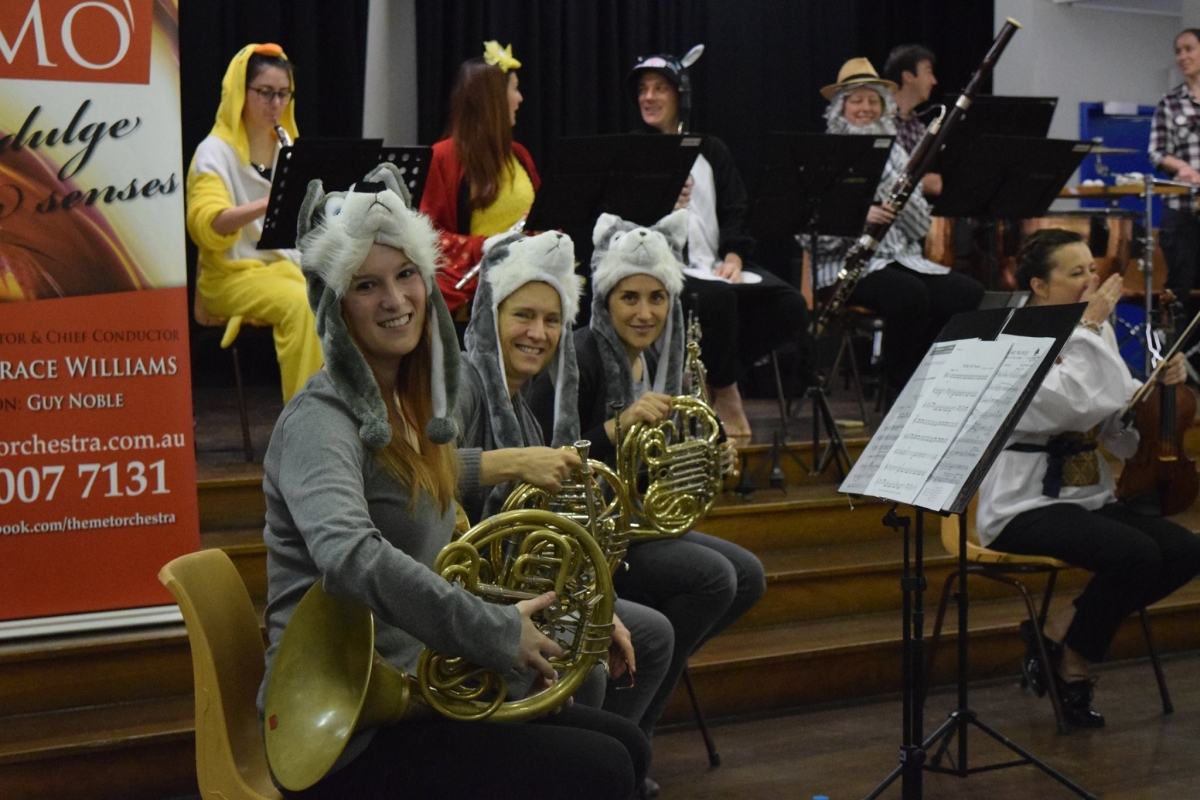The Metropolitan Orchestra breaks down barriers by performing for refugees, most of whom had never seen an orchestra before.
The Metropolitan Orchestra, in conjunction with St Vincent de Paul Society NSW’s SPARK programme, delivered two concerts to newly arrived refugee families in Sydney’s Western Suburbs last month. The orchestra performed for close to 200 parents and children, many of whom had only been in Australia for a few weeks, across two kid-friendly Cushion Concerts featuring Prokofiev’s well-loved Peter and the Wolf at Fairfield Public School, with the narrator, Tyran Parke, supported by an Arabic interpreter.
The initiative came about after one of the SPARK programme’s officers, who had attended several TMO concerts, approached the orchestra’s General Manager Bevan Rigato in 2014. After two years of planning and coordination, the concerts took place on September 26, to an audience of new-arrivals, almost all of whom had never seen an orchestra before.
 Narrator Tyran Parke and TMO performing Peter and the Wolf
Narrator Tyran Parke and TMO performing Peter and the Wolf
“We determined that our version of the Family Cushion Concert featuring Peter and the Wolf would be perfect for this audience,” Rigato told Limelight. “We included our narrator and worked with SPARK to create pre-programme notes that were distributed to invited families in Arabic, which discussed the script and the characters of Prokofiev’s classic story. We also organised for an interpreter to come along and assist in some of the translations and give our narrator, conductor and musicians some rudimentary terms and phrases that they could use in Arabic to help connect with the audience during and after the performance. This approach was very much appreciated and really broke down the barriers between musician and audience (parent and child alike).”
Audience participation was encouraged, the event designed to foster interaction between children and musicians. “Our version of this show includes 15 minutes after the concert where the musicians mingle with the audience,” explained Rigato. “Here they chat with the kids and their parents, show them their instruments and play various tunes that many of the kids may know – themes from Frozen, Star Wars, etc. Here they get to talk with the kids and ask them how they felt.”
The concerts were designed as a way of providing an opportunity for new-arrivals to enjoy a unique community experience as well as an exciting and safe way to meet people and socialise in their new community. “The impact both during and after the show was phenomenal. Children were enraptured with the music and the performance including the fact that our musicians were all dressed up as characters from the story along with our animated narrator who brought it all to life. After the show the kids made it a mission to speak with as many different musicians as possible to see how their instruments worked during the mingle session, and parents were very keen to get photographs with their families and the musicians. The smiles were phenomenal and more than once a child expressed interest in learning a particular instrument.”
 The horn section dressed up for the occasion
The horn section dressed up for the occasion
For Rigato, it was particularly moving to learn about the stories of refugees coming to Australia. “The week prior to our concert was Refugee Awareness Week,” he said. “On the walls of the school hall in which we performed were stories and pictures that the kids wrote about their harrowing journeys from their homelands to Australia. They were truly heartbreaking! Stories written by seven and eight-year-olds who used to live “in a mansion” and enjoyed walking to school with their friends, when one day their parents say they have to leave. They up and left all their belongings behind, some having to walk six hours or more for the bus, which they would wait for hours to catch. This then took them to a camp where some of them remained for three years before getting the opportunity to come to Australia. These are just some of the many tales.”
There were also drawings. “One very memorable image shows a country in flames,” Rigati said, “a child in a plane questioning his or her future (a big question mark coming out of a thought bubble) as they travel to a new land and new life. Just knowing of some of their experiences made us look at these kids in amazement (and we all left with very big smiles on our faces and in our hearts). I think for everyone involved, it was a completely, and unexpectedly rewarding experience.”
“Probably the most important benefit that has come from this initiative,” said Rigato, “is the reality that presenting live music in this styled environment to this type of audience is not only possible, it actually works and can deliver real results! This format (or variations thereof) can be used to deliver even greater musical benefits to reach more people and break down more barriers.”
For Rigato, the arts have a unique opportunity to take the lead in situations like this. “We all know that music can change lives,” he said. “Music is a common factor in all cultures, even though the style can be different, the music and music making is something that all can appreciate. We felt that the music removed any real or perceived barriers during this engagement. It removed any inhibitions and opened minds to the possibilities of being able to perform and play music. However it was not just the audience (parents and kids) that were affected. The looks on the kids’ faces and the realisation that they were experiencing a live orchestra for the first time had a massive impact on all the musicians and all the management and volunteers. It was a moment that amplified just how powerful something like an orchestra, or any live ensemble can be for young minds. They could see that music doesn’t just come from an iphone or ipod, it comes from a real instrument, performed by real players. This is where it all begins.”











Comments
Log in to join the conversation.